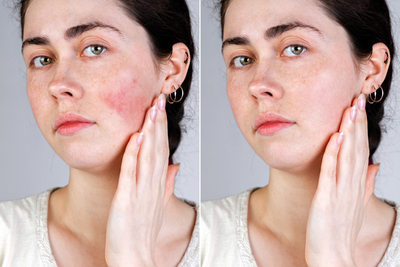April is Rosacea Awareness Month

Now is the perfect time to talk about rosacea, a chronic skin condition that affects over 16 million Americans. April is Rosacea Awareness Month and the more you know about the triggers, symptoms and best treatments for rosacea, the more you can successfully deal with it. Many people mistake rosacea for acne and make the mistake of treating rosacea with acne products, only to worsen their condition. If you think you have rosacea, please consult a dermatologist immediately to make sure you are receiving proper treatment.
Here, Schweiger Dermatology’s Dr. Jeremy Fenton shares the news on the latest in-office treatments/procedures to treat rosacea:
The Best Prescription Treatments for Rosaces
“One of the most frustrating components of rosacea is the persistent redness and flushing that many patients deal with,” says Dr. Fenton. “Most of the topical and oral medications target the papules and pustules, but are minimally effective for this redness. The latest medication for the redness is Rhofade. For some patients, Rhofade can significantly decrease the redness for about 12 hours. It constricts the blood vessels and produces a temporary effect that lasts most of the day.” Rhofade is an improvement over prior topical treatments for redness, because the risk of rebound redness is reduced. There is also some preliminary evidence that long-term use can create a lasting effect that prevents the redness from worsening over time.
Ivermectin cream and Finacea (azelaic acid) remain the two most effective prescription medications. A once-daily cream that targets inflammatory lesions and helps control Demodex mites, which are believed to play a role in rosacea flare-ups.
The Best In-Office Rosacea Treatments
The most effective and long-term rosacea solutions are in-office laser treatments. These lasers target the blood vessels at the surface of the skin, which are responsible for the redness. Originally, most of these lasers required significant downtime with bruising. However, Dr. Fenton now prefers to either use the KTP laser for rosacea, which does not leave behind any bruising, or use the pulsed dye laser (PDL) at settings that won’t bruise. This procedure has little downtime, usually just some increased redness for about 24 hours. After 3-4 treatments, patients usually see a significant reduction in the redness that can last for 3-4 years.
Lifestyle Tips for Rosacea
Rosacea patients should get to know their triggers and avoid them. Common triggers include spicy foods, alcohol, hot drinks, and large changes in temperature. Patients should always use a sunscreen as well, because chronic sun exposure will increase that persistent redness and make prominent blood vessels more visible.
The Best Drugstore Products for Rosacea
“Patients with rosacea should use gentle cleansers and avoid anything that may irritate the skin, which can bring out more inflammation,” says Dr. Fenton. For basic moisturizers and facial washes, he recommends products designed for sensitive skin such as Cetaphil or Cerave as well as Clinique Redness Solutions Daily Relief Cream. He recommends a quality zinc oxide-based daily sunscreen, such as Elta MD’s UV Clear SPF 46, which contains niacinamide to help calm inflammation.
